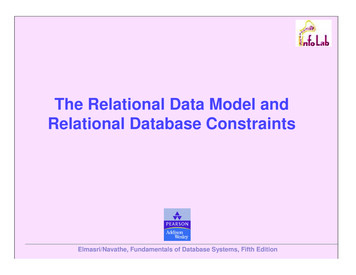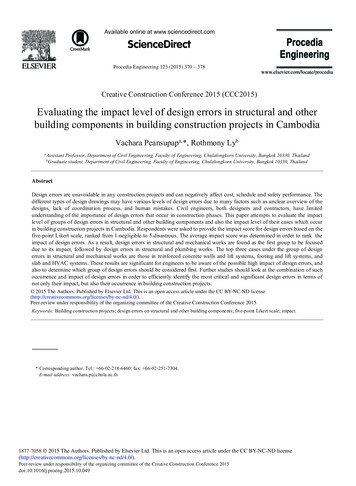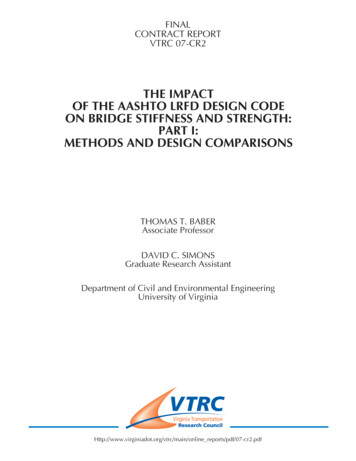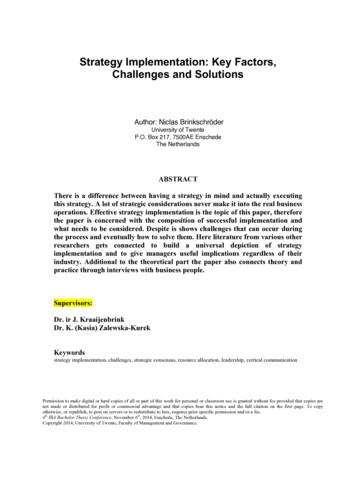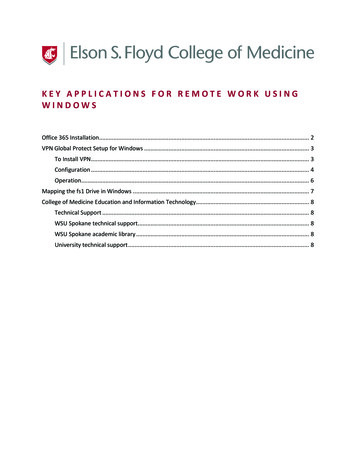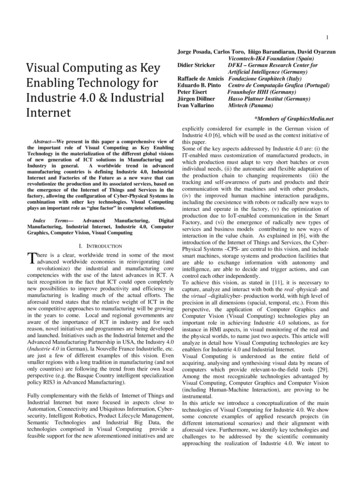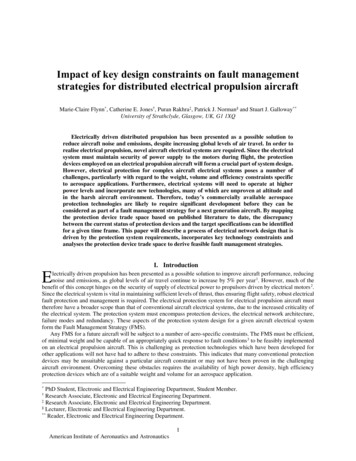
Transcription
Impact of key design constraints on fault managementstrategies for distributed electrical propulsion aircraftMarie-Claire Flynn*, Catherine E. Jones†, Puran Rakhra‡, Patrick J. Norman§ and Stuart J. Galloway**University of Strathclyde, Glasgow, UK, G1 1XQElectrically driven distributed propulsion has been presented as a possible solution toreduce aircraft noise and emissions, despite increasing global levels of air travel. In order torealise electrical propulsion, novel aircraft electrical systems are required. Since the electricalsystem must maintain security of power supply to the motors during flight, the protectiondevices employed on an electrical propulsion aircraft will form a crucial part of system design.However, electrical protection for complex aircraft electrical systems poses a number ofchallenges, particularly with regard to the weight, volume and efficiency constraints specificto aerospace applications. Furthermore, electrical systems will need to operate at higherpower levels and incorporate new technologies, many of which are unproven at altitude andin the harsh aircraft environment. Therefore, today’s commercially available aerospaceprotection technologies are likely to require significant development before they can beconsidered as part of a fault management strategy for a next generation aircraft. By mappingthe protection device trade space based on published literature to date, the discrepancybetween the current status of protection devices and the target specifications can be identifiedfor a given time frame. This paper will describe a process of electrical network design that isdriven by the protection system requirements, incorporates key technology constraints andanalyses the protection device trade space to derive feasible fault management strategies.I. IntroductionElectrically driven propulsion has been presented as a possible solution to improve aircraft performance, reducingnoise and emissions, as global levels of air travel continue to increase by 5% per year 1. However, much of thebenefit of this concept hinges on the security of supply of electrical power to propulsors driven by electrical motors 2.Since the electrical system is vital in maintaining sufficient levels of thrust, thus ensuring flight safety, robust electricalfault protection and management is required. The electrical protection system for electrical propulsion aircraft musttherefore have a broader scope than that of conventional aircraft electrical systems, due to the increased criticality ofthe electrical system. The protection system must encompass protection devices, the electrical network architecture,failure modes and redundancy. These aspects of the protection system design for a given aircraft electrical systemform the Fault Management Strategy (FMS).Any FMS for a future aircraft will be subject to a number of aero-specific constraints. The FMS must be efficient,of minimal weight and be capable of an appropriately quick response to fault conditions 3 to be feasibly implementedon an electrical propulsion aircraft. This is challenging as protection technologies which have been developed forother applications will not have had to adhere to these constraints. This indicates that many conventional protectiondevices may be unsuitable against a particular aircraft constraint or may not have been proven in the challengingaircraft environment. Overcoming these obstacles requires the availability of high power density, high efficiencyprotection devices which are of a suitable weight and volume for an aerospace application.*PhD Student, Electronic and Electrical Engineering Department, Student Member.Research Associate, Electronic and Electrical Engineering Department.‡Research Associate, Electronic and Electrical Engineering Department.§Lecturer, Electronic and Electrical Engineering Department.**Reader, Electronic and Electrical Engineering Department.†1American Institute of Aeronautics and Astronautics
A conventional aircraft electrical design methodology would involve selecting a baseline architecture to meet theaircraft requirements. Then by performing trades with various aspects of electrical system performance, this initialarchitecture would be altered in an iterative process in order to meet the system constraints, and in doing so, convergeon an optimal electrical architecture which incorporates all the necessary design considerations.Whilst in any electrical architecture design process an initial starting configuration is desired, the authors proposean alternative design methodology as an academic exercise. The design of electrical propulsion aircraft is bothchallenging and subject to technology barriers. For example, protection devices rated for MW electrical systems whichare proven in an aircraft environment do not yet exist, and full scale testing of complete protection systems forelectrical propulsion aircraft (including measurement, control, load management and network reconfiguration) haveyet to be realised. Therefore, as the protection system for future aircraft is currently subject to a large degree ofuncertainty, it is beneficial to reduce the power system architectures solution space by eliminating protectionmechanisms which have little probability of success. The suggested novel approach aims to derive electricalarchitectures, for which an adequate FMS can realistically be implemented using the electrical protection technologieslikely to be available within a given developmental timeframe.This process is iterative, and the selection of FMS and thus architecture would recommence to capture variationsin aircraft requirements or available technologies. Since the FMS encapsulates many aspects of system design (e.g.redundancy, choice of AC or DC power, number of power flow channels) it is imperative that the protection systemis considered at the outset, together with the design of the aircraft configuration. This prevents an electrical architecturefrom being selected for an aircraft for which there are no suitable protection devices, or where the benefits of theelectrical propulsion system are negated by the weight penalty associated with their use.A. Technology Roadmaps and DevelopmentsThe expected Entry Into Service (EIS) for various sizes and power ratings of electrical propulsion aircraft arestaggered across a number of defined timeframes, ranging from the present (N) to around 2040 (N 4)4. Aircraftmanufacturers must be able to finalise the electrical system design an appropriate period of time prior to the actualEIS for the aircraft. Therefore, electrical protection devices must have reached high TRL, demonstrated the requiredspecifications and passed certification standards at this aircraft definition stage if they are to be suitable for use.As aircraft electrical systems evolve across a range of power transmission arrangements (AC, DC or a mixedcombination) a greater variety of devices will be required to match these advances in system configuration. Theaddition of large propulsive loads on the system and increased electrification of subsystems, means that future aircraftprotection devices will also have to operate at higher power ratings. This is likely to require novel protection devicessuch as MVDC (Medium Voltage Direct Current) breakers and Superconducting Fault Current Limiters (SCFLs),both of which are unproven in an aircraft application. Therefore, today’s commercially available protection devicesare likely to require significant development or substitution by a superior technology before the stringent FMS designcriteria can be met. Current and near future electrical propulsion aircraft are limited to small scale demonstrators orgeneral aviation aircraft. However, the number of passengers per aircraft and the electrical power ratings are set toincrease incrementally, with fully electric large passenger aircraft remaining a long term goal.II. Database CriteriaIn order to assess the discrepancy between current state-of-the-art and future optimal protection system capability,it is necessary to establish the landscape regarding protection devices. A knowledge database has been compiled toillustrate the current level of development of a variety of circuit breakers, SFCLs and power electronics converters(which can offer a range of fault management functions) potentially suitable for distributed propulsion aircraftapplications. Since the rate of improvement of various technologies is unknown, devices have been considered acrossa range of TRLs (Technology Readiness Level), from patented technologies to commercial products. This databasewill be reviewed regularly in order to capture any shift in industry focus or significant improvements in a givenprotection technology.B. Technology Readiness Level SelectionThe TRL for each device or project in the database was categorised based on the TRL stages developed by NASA5.The exact TRL level (0-9) for some projects is difficult to ascertain based on the published data, so the TRL ratinghas been simplified into three broad stages as follows:1) Low TRL – evidence of patents, computational modelling and simulations or conceptual description2) Medium TRL – evidence of lab based prototype, hardware testing or scaling up of initial testing3) High TRL – evidence of extensive in-field testing or commercially available2American Institute of Aeronautics and Astronautics
The TRL listed in the database is based on the latest available publications and is noted alongside the date ofpublication for completeness.C. Cross-discipline TechnologiesThe database presented in this paper enables identification of complexities introduced when applying devicesordinarily used within HVDC (High Voltage Direct Current) systems, traction applications, terrestrial grids, naval andmarine systems, solar systems and electric vehicles to electrical propulsion aircraft. In reviewing the literature andcompiling the database to this point it is clear that there are no off-the-shelf protection devices which are currentlysuitable for future aircraft. Therefore, in the first instance, devices which have been developed for other applicationsmust be considered. In order to demonstrate this, a number of application areas with particular relevance to aircraftelectrical systems are discussed below.1. HVDCHVDC electrical systems are advancing DC power technologies such as high voltage DC converters6. This maybe beneficial where aircraft systems are DC, since the TRL level and availability of devices should increase. This areaof the industry has also identified the need for standardisation of technologies and operating points, such as a commonDC voltage level7. As the standards for novel aircraft electrical systems are still under development and remain largelyundefined, this will prove useful as an indicator of the level of standards that future electrical aircraft protection deviceswill have to comply with.2. Terrestrial GridMicro-grids and smart grids are another application area with relevance to future aircraft. The type of protectiondevices deployed on the national grid are normally large, robust, well established technologies, which dictates thatthere would need to be a reduction in scale to aircraft systems. However, the pressure on the network to maintain everincreasing levels of supply and manage distributed generation mean that greater flexibility of network managementand protection is needed. This has led to the development and installation of novel SFCLs on congested networks 8,9in the UK. If SFCLs can be proven in the field as a cost-effective and reliable means of reducing maximum faultcurrent, then there is a possibility that SFCLs might transfer to other applications where fault current limitation mayprovide significant benefits. The increased level of monitoring and measurement that is being applied to smart grids 10is also interesting for electric propulsion aircraft as the critical power train network is likely to include a large numberof sensors to ensure power quality and delivery is maintained.3. Naval and MarineNaval protection devices are of particular interest as there is a similar need for high reliability, high power densityand high speed of response, while the fact that naval electrical propulsion systems have reached a higher maturityprovides a testing ground for new technologies. Whilst naval systems are subject to weight and volume constraints,these are not as stringent as for aircraft applications, and so it is not clear if and how devices and architectureconfigurations will scale down. The naval circuit breaker devices and fault current limiters listed in the database aremuch too sizeable for aircraft at present, and so reduction in weight and volume remains a key developmental goal.Furthermore, electrical standards for the US Navy electric warship program are already under development11, and thisis seen as a key part of integrating electrical power technologies into future vessels. This provides a good basis for thedevelopment of standards for future electrical aircraft systems as these specifications can be used as a reference forstandardising aspects of MVDC distribution and novel protection mechanisms.4. SolarSolar energy systems present an opportunity to advance aircraft protection technology. Since it is highly likely thatenergy storage (possibly in the form of batteries, super capacitors, or magnetic energy storage) will play a role ineither the normal or faulted operation of the power train system, this requires power conversion where the system isAC, or energy storage control where the system is DC. As the size of solar power plants have increased over recentyears the power conversion devices which have been developed to support this integration to the wider grid have alsoachieved higher power ratings and reduced losses. However, similar to the naval systems these devices are still not ona scale that would be feasible for an aircraft. Furthermore, there is a difference
Marie-Claire Flynn*, Catherine E. Jones . HVDC electrical systems are advancing DC power technologies such as high voltage DC converters6. This may be beneficial where aircraft systems are DC, since the TRL level and availability of devices should increase. This area of the industry has also identified the need for standardisation of technologies and operating points, such as a common DC .
